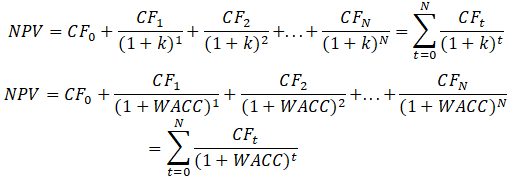The net present value (NPV) method is simple and powerful: All future cash flows are discounted at the project’s cost of capital and then summed. Be aware that cash flow at time zero (CF0) is usually a negative number as this may be an initial capital investment in the project. Complications include differing life spans and different rankings using IRR. The general rule is if NPV > 0, accept the project; if NPV < 0, reject the project; if NPV = 0, you are indifferent (other qualitative variables need to be considered). The NPV is the sum of cash flows (CF) from time zero (t = 0) to the final cash flow period (N) discounted as some discount rate (k), which is typically the weighted average cost of capital (WACC):
NPV has a direct relationship between economic value added (EVA) and market value added (MVA). It is equal to the present value of the project’s future EVA, and, hence, a positive NPV usually implies a positive EVA and MVA.

